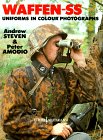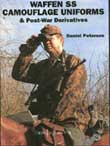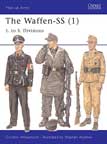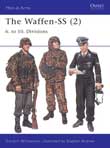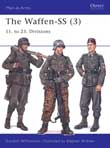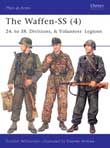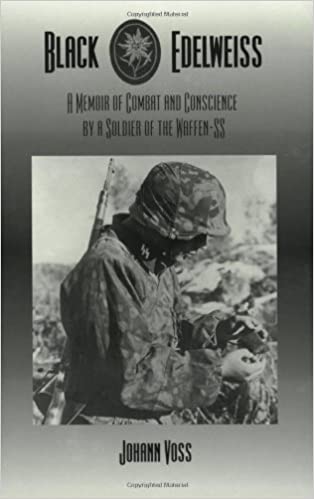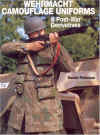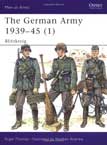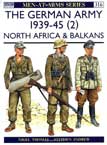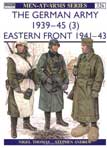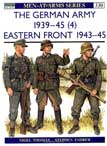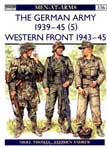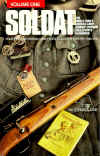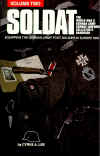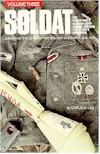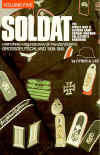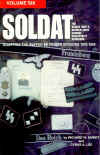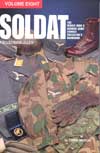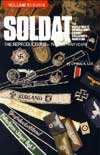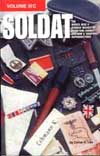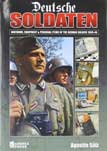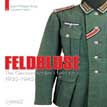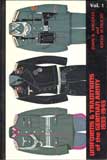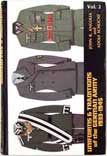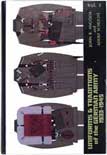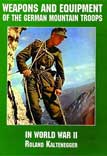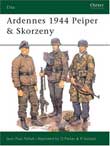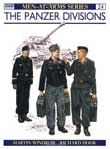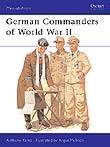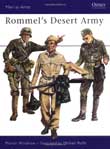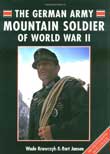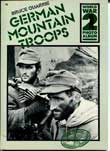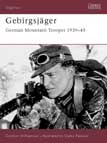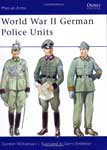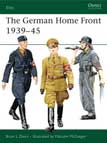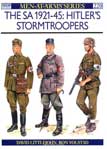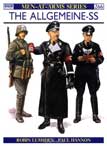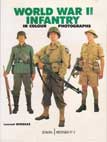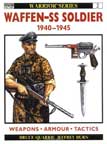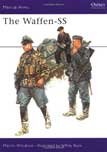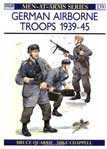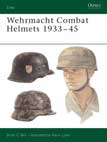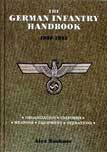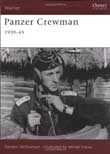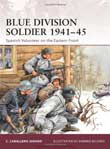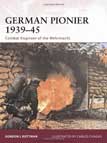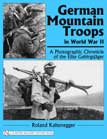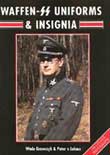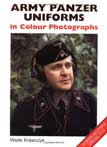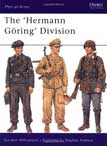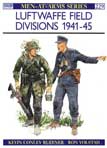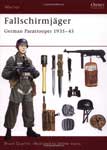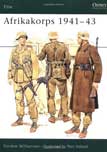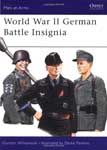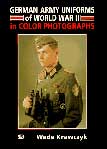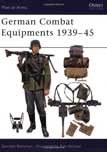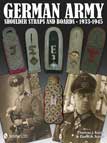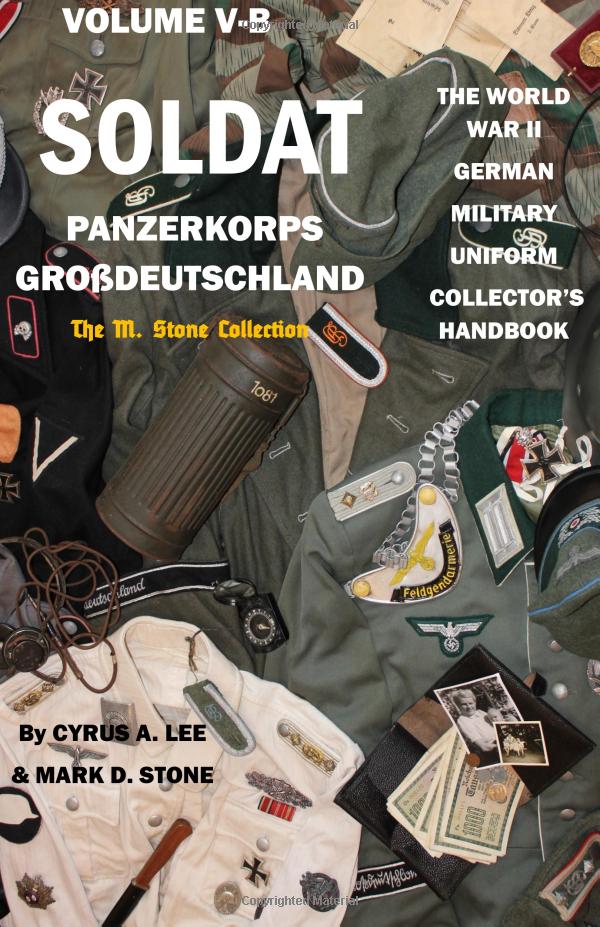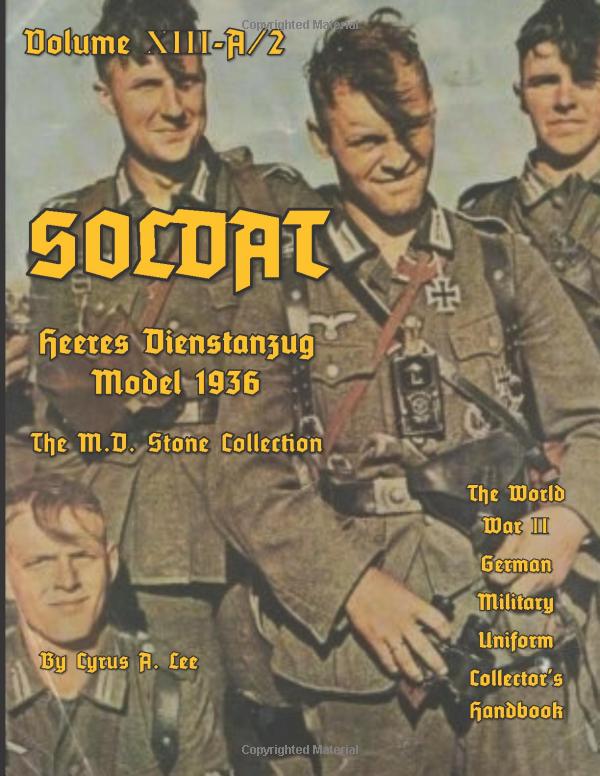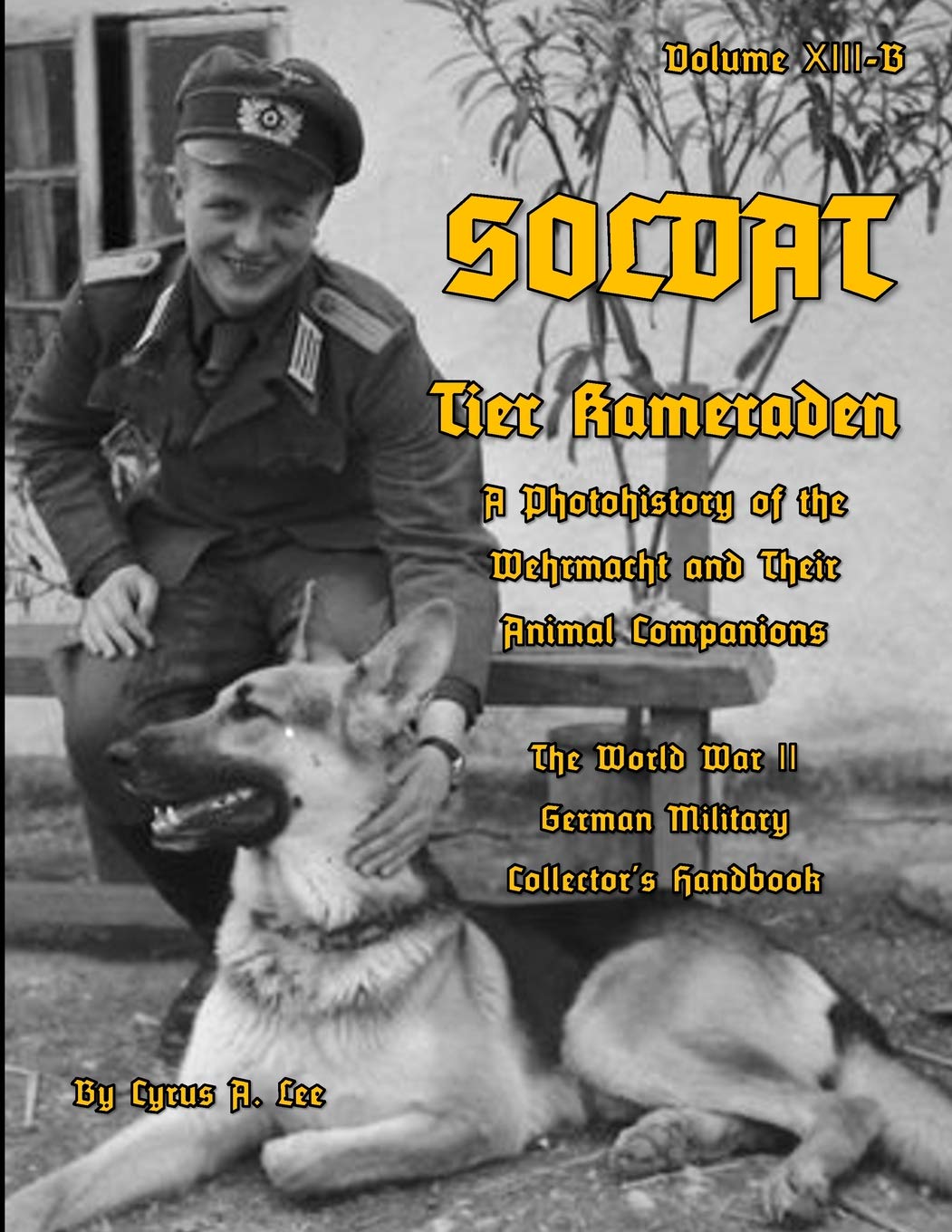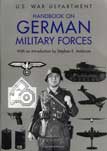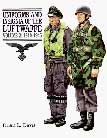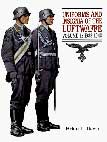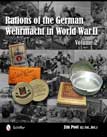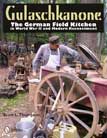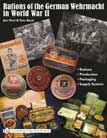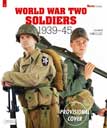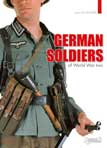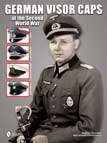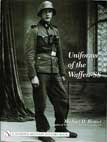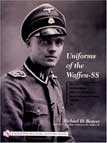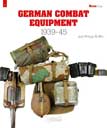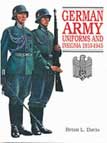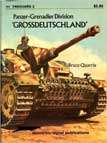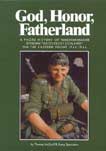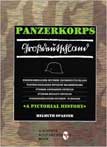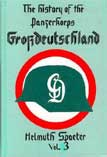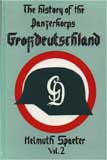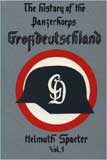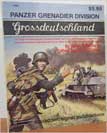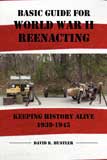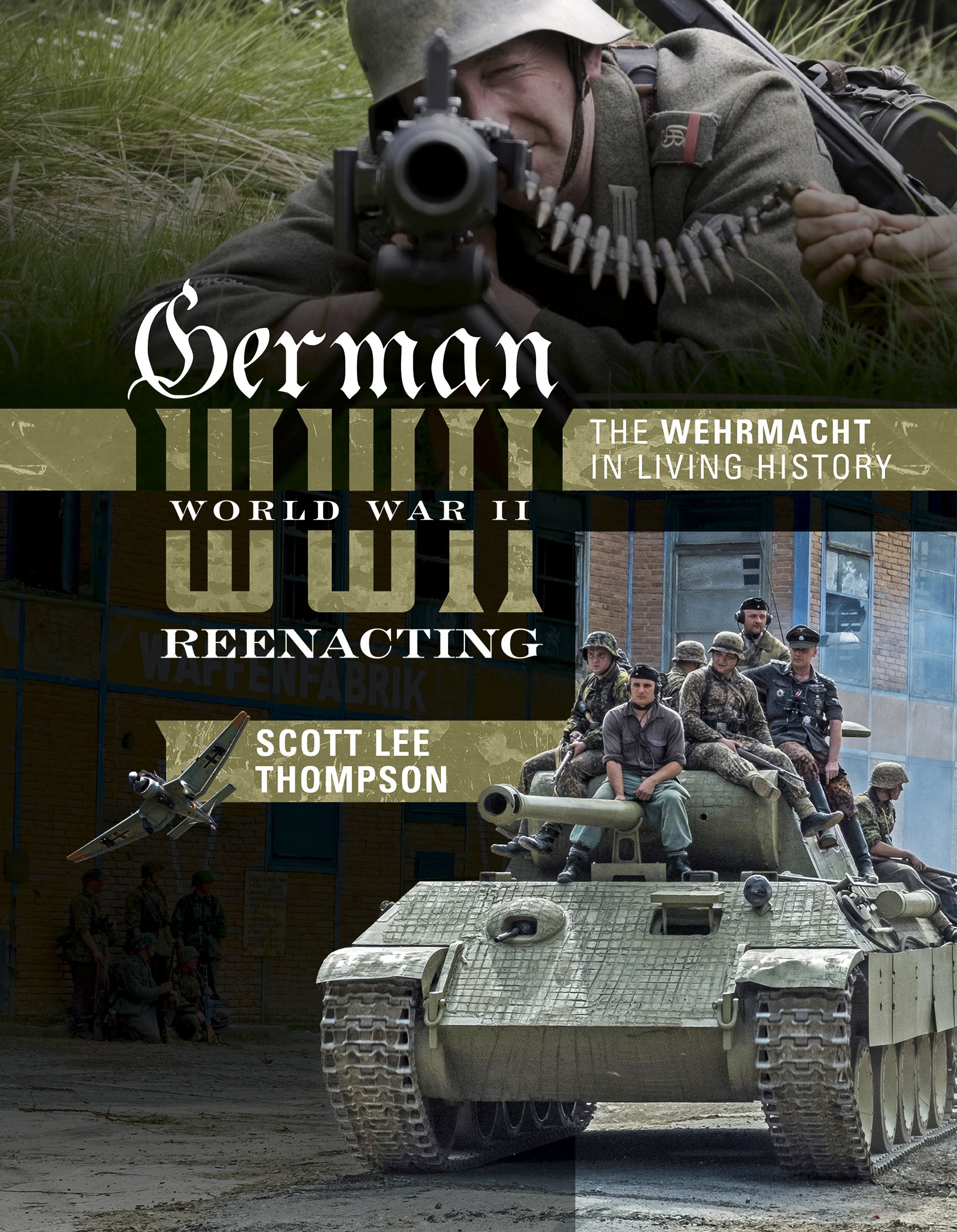

This book, Waffen-SS Uniforms: In Colour Photographs is, without a doubt, a MUST HAVE for any WWII library! Although I have seen a reviewer state that the uniforms were mostly reproductions, he is wrong, as pretty much everything in this book is real! You won't get this kind of great colour photos in any book this cheaply -- if you don't buy it, you're an idiot!
This book is a unique reference source for the uniform collector, modeller and student of military dress and equipment.For the first time the reader can trace the development of the colour and design of the Waffen-SS uniforms with confidence: all the uniforms worn in the 150 colour photographs presented here are rare, original items, from private collections. All major types of service uniform are illustrated, together with a full range of the unique camouflage clothing which was the hallmark of these much-feared divisions.Privates, NCOs, officers, infantrymen, mountain troopers, tank and assault gun crews are all vividly illustrated here as they appeared on the actual battlefield, and described in detail.
When this book came out, it was groundbreaking, and today, it is STILL a very good book.
All the patterns used by the formidable troops of the Waffen-SS, from the first revolutionary designs of the late 1930s to little-known innovations of 1945, are explained and illustrated by means of more than 120 colour photographs of rare, original surviving specimens. The book also covers similar and derivative patterns used by German and foreign armies up to the modern day; and gives invaluable advice on the identification of original wartime uniforms. Useful for collectors, uniform historians and military modellers alike, this title aims to resolve the confusion surrounding this subject and establishes and complete and concise system of identification and terminology.
Despite being disdained by the German Army’s professional officer corps, the military branch of the Nazi SS security organisation grew from an initial strength of only a handful of battalions at the outbreak of World War II in 1939, to hundreds of thousands of troops in dozens of divisions. The battlefield reputation of the premier armoured and mechanised divisions would become second to none; lavishly equipped and regarded as utterly reliable, they were thrown into many desperate battles on both Western and Eastern fronts, often achieving remarkable results. Illustrated with rare photographs, this first of four Men-at-Arms titles details the organisation, uniforms and insignia of the Waffen-SS.
The military branch of the Nazi SS security organisation grew by the end of World War II (1939-1945) from a handful of poorly regarded infantry battalions in 1939, into a force of more than 30 divisions including units of every type. Their battlefield reputation varied widely, from the premier armoured divisions which formed Germany's utterly reliable spearheads on both main fronts, to low quality 'anti-partisan' units. The divisions covered in this second of four titles include the first mountain and cavalry units, and two of the remarkable new Panzer divisions raised in the great 1943 expansion. Illustrated with rare photographs from private collections, the text details their organisation, uniforms and insignia, and summarises their battle record.
The Waffen-SS grew from a handful of obscure infantry battalions in 1939, to a force of more than 30 divisions by the end of World War II, including units of every type and every level of battlefield value. The mid-war divisions covered in this third title represent that range, from some of the most effective German and Western European volunteer formations – e.g. the 12. SS-Pz Div 'Hitlerjugend', and the Scandinavians and Dutchmen of the 11. 'Nordland' and 23. 'Nederland' divisions – to the Bosnian Muslims of the anti-partisan 13. 'Handschar' Division. Illustrated with rare photographs from private collections and meticulous colour artwork, the text details their organization, uniforms and insignia, and summarizes their battle records.
In the last years of World War II, 1944–45, the Waffen-SS formed many nominal 'divisions' from a motley range of sources, whose battlefield value was as varied as their backgrounds. The best were built around existing Western European volunteer regiments; some, raised from Central Europeans and Russians, were strong in numbers but weak in morale; some were of negligible size, scraped together from remnants and trainees; and some were sinister 'anti-partisan' gangs, assembled from the military dregs of the Eastern Front. Illustrated with rare photographs from private collections and meticulous colour artwork, this final title in our sequence details their organisation, uniforms and insignia, and summarises their battle records.
In no other country has camouflaged clothing been so extensively used, and in such great diversity of patterns and styles, as in Germany. For the first time, US Army museum curator Dan Peterson traces the evolution and development of the camouflage uniforms of the German armed forces by means of vivid colour photographs of one of the world's most extensive collections of original examples.
Here he examines the broad category of camouflage patterns and uniform types used by the German Army and Air Force troops of World War Two, and those post-war patterns that were clearly derived from the Wehrmacht types - some still in use over half a century later.
Indispensable for collectors, uniform historians and military modellers alike, this book finally resolves the confusion surrounding many of these patterns and garments, and establishes a complete and concise system of identification and terminology.
On 1 September 1939, when Germany attacked Poland, the Wehrmacht numbered 3,180,000 men. It eventually expanded to 9,500,000, and on 8-9 May 1945, the date of its unconditional surrender on the Western and Eastern Fronts, it still numbered 7,800,000. The Blitzkrieg period, from 1 September 1939 to 25 June 1940, was 10 months of almost total triumph for the Wehrmacht, as it defeated every country, except Great Britain, that took the field against it. In this first of five volumes examining the German Army of World War II (1939-1945), Nigel Thomas examines the uniforms and insignia of Hitler's Blitzkrieg forces, including an overview of the Blitzkrieg campaign itself.
Hitler first considered an invasion of Great Britain in autumn 1940, then scheduled Operation Barbarossa, the conquest of the European part of the Soviet Union, for May 1941. Anxious to emulate Hitler's successes, the Italian dictator Mussolini embarked upon unnecessary military adventures in North Africa and the Balkans, which forced Hitler's intervention, diverting and depleting precious German resources, and a six-week postponement of Barbarossa. In this second of four volumes [Men-at-Arms 311, 316, 326 & 330] on the German Army of the Second World War, Nigel Thomas examines the uniforms and insignia of the forces involved in North Africa and the Balkans.
Operation Barbarossa, the attack on the Soviet Union, commenced on 22 June 1941. It became the biggest conflict in military history, with some three million German troops and about 900,000 allies facing almost 4.7 million Soviet troops. The effects would colour postwar European history for the next 50 years. This title examines the history of the conflict, and the organisation, uniforms and insignia of the German Army on the Eastern Front during World War II, from 1941-43. The book contains numerous illustrations and photographs throughout, incuding eight fine full-page colour plates by Stephen Andrew.
In early 1943, the annihilation of the 6th Army at Stalingrad marked the irreversible turning-point of World War II (1939-1945) in the East. Despite occasional local successes gained in the face of great odds – testimony to the Wehrmacht’s extraordinary resilience – from now on Germany was on the defensive. Despite Hitler’s damaging interference the quality of German field leadership, and of new weapons, remained high; but each new Soviet offensive pushed the front line closer to – and finally, across – the borders of the Reich. In this fourth title of their sequence author and artist describe and illustrate the developments in unit organization, uniforms and equipment during 1943–45, including information on European and Eastern volunteer units; text and illustrations are supported by detailed tables.
This book covers the high command, the developments in unit organisation, the campaigns and the uniforms and equipment of the German Army in the last two years of the war in North-West Europe and Italy. Despite the huge pressure of fighting on three fronts, ever-worsening shortages of manpower and equipment, and Allied command of the skies, Germany's decimated divisions fought on with impressive skill and determination. This period of World War II (1939-1945) also saw a fascinating mixture of obsolescent, newly designed, and field-made combat clothing which gave the German soldier a radically different appearance from his predecessor of just five years before.
The handbook for the collector and reenactor of German Army combat uniforms, equipment, and weapons for the period of 1939 - 1942. Contains first hand accounts of action in France and Russia. Also included is the Soldat Guide to European Museums and Battlefields.
The premiere volume of the Soldat series; with this little book it all began. Contains details of the uniform, equipment, and weapons of the German Army Combat Soldier of 1943.
SOLDAT is designed as a handbook for the collector of German Army combat uniforms, equipment and weapons. This volume provides not only current, detailed photographs of combat uniforms and individual equipment of the foot soldier, but also a look into his life and time in the critical years of the war, 1944 and 1945. The detailed photos in SOLDAT provide the military modeler with needed exacting details and the color plates will provide exact color references of combat uniforms, equipment and weapons. The "alte Hase," the combat veteran, provides the collector with a link to the stories and ideas of the foot soldier. Volume III is the second in a multiple volume series that will provide the collector with a handy reference book on the German Army foot soldier through the war years of 1939 through 1945. Future works of SOLDAT will expand further into the life and times of the foot soldier. SOLDAT Volume Ill is a perfect reference for anyone interested in the subject of combat uniforms and equipment of the German Army foot soldier in the Second World War. SOLDAT will continue to grow with the hobbyist.
The first Soldat to look specifically at a single elite German Army unit, Panzerkorps Großdeutschland. This volume show details of the Heer Panzer and Assault Gun uniforms, along with rare Reed Green HBT panzer uniform items. Also included is a 1932 picture manual on the Zeltbahn and its various uses.
SOLDAT is designed as a handbook for the collector of German Army combat uniforms, equipment and weapons. Uniforms and Insignia of Panzerkorps Grossdeutschland is the first SOLDAT to deal with a specific German Army organization. This SOLDAT provides the reader with unique insights into this elite German Army fighting formation. Through detailed, current, black and white photos the collector, modeler, and historian can view the progression of uniforms and insignia used and worn by Grossdeutschland throughout the war. The text details how the uniforms and insignia applied to and were used by the soldiers of Grossdeutschland. Color photos provide the hobbyist with the exact information required for research of the color details of uniforms and insignia. Der alte Hase provides insight into the life and times of the "Grossdeutschen." Uniforms and Insignia of Panzerkorps Grossdeutschland is a perfect first book for the collector, the modeler, or historian who is interested in the German combat soldiers of World War II . When combined with other SOLDAT volumes, this book provides a very inclusive reference set that spans the years of German involvement in the Second World War.
The first Soldat to deal with other than Heer troops. Researched by Richard Mundt, this book is a detailed study of the Waffen-SS Panzer Divisions. Filled with unpublished period photos and close up, new photos of insignia, this book provides a new look at an always-topical subject.
[Just for the record, Marsh type-set this book back in the day... be careful when you complain to much. LOL. I kept bugging Cyrus Lee about using SS runes like they were supposed to be. Guess who had to MAKE a SS-Runes font and then typeset the book. :-P ]
Fallschirmjäger--An in-depth study of this elite branch of the German military by subject are expert Chris Mason. Going where no work on the subject has yet to go and filled with unpublished period and detail contemporary photos this work is a bench mark.
Soldat, Vol. 11: Reproductions—The Post War Years. This is the book that will refund you its cover cost the first time you spot a fake and put it back on the dealer' s table! Filled with hundreds of detailed photos of FAKES with step-by-step tips for identification. Arm yourself!
The World War II German Reenactor's Guide and Combat Uniform & Equipment Reproductions--A handbook for German reenactors and living historians that will produce top of the line First-Pperson impressions. Detailed photos of todate combat uniforms and equipment that will guide the collector through the field of fakes! $15.95 Alas, this book isn't available from Amazon ;-(
Here is a great review of the book (yes, I'm biased):
Reviews
"I just got a copy of Cyrus Lee's new book Soldat XI C about reenacting the German impression. If your unit does not have a handbook then you should buy this book and hand them out to your unit. It really covers just about all of the subjects that we need to know for reenacting. Wonderful explanations and plenty of pictures for everyone to see. Excellent job on the book. I highly recommend this book, and not just because some of my units pictures in it. It's worth it for the sections on language skills, tactics, and drill. Marshall Wise's "Building a Persona", page 120, is something we all need to do to improve our impressions. I always believed that it's the "details, details, details" like simply wearing and carrying your Erkennungsmarken or Soldbuch. No one sees them but you know that at least your carrying it like the 8 million men did in the Wehrmacht."
Bob Lawrence. 7. Großdeutschland
There have been all manner of books written on the German Army since the end of World War II. Books on the men, their tactics, commanders, equipment, weaponry and histories of the major battles they fought in can be found on the bookshelves of almost all 20th Century history enthusiasts.
Deutsche Soldaten is a stunning visual history of the German soldier and provides a unique reflection of how the men lived, ate, and washed themselves on the front, or behaved when at rest, what were their pastimes, ambitions, worries and how they spent their leave, through the collections of personal items and other artifacts they left behind.
The author, an expert on 20th-Century military history and an avid collector of military items from many different armies, makes available to the general public for the first time all these artifacts which he has collected over the years in order to create this complete illustrated history.
This book can best be understood as a G.I. Collector's Guide (Histoire and Collections, 2005) for the German soldier. The treatment is very similar with page after page of pieces of uniform and equipment the even the most knowledgeable collector will find new items amongst. There are a great many close up photographs that will be invaluable for collectors looking to see what the genuine article looks like.
Lavishly illustrated with thousands of color photographs, this large format book is being jointly produced by Casemate and Andrea Press in Spain.
To gain a full understanding of the level of detail contained in the book, please visit our website where you can see a selection of sample spreads.
REVIEWS
"an interesting forensic look at the late 1930s/early 1940s through a modern look at the 'kit" of the average soldier. An invaluable reference...definitely recommended." Cybermodeler.com, 12/2008
"marvelous, educational collection offers an exceptional testimony of a man in the name of all men who were made protagonists very much in spite of themselves." Bill Stone. 12/2008
"...by far the best illustrated reference on the uniforms and equipment of the German Soldier in WII that I have ever seen. A must have for militaria collectors, re-enactors, illustrators and costumers." Larry Hama, 12/2008
"a fascinating book... invaluable to modelers as well as collectors and historians. Very highly recommended" Internet Modeler, 12/2008
"...possibly the very best reference book on WWII German infantry uniforms and field equipment ever written. The color photography..is outstanding... For the collector of German WWII pieces, this book would be a necessity. For the rest of us, it is a fascinating read on the soldier's life from a perspective we have not seen before." International Plastic Modeler's Society, 1/2009
"...an exceptional reference for modelers, Militaria Collectors and general Military History buffs as well. A Must Have." Armor Modeler and Preservation Society, 01/2009
"This lavish and generous publication is a visual feast produced to the very highest production standards to show the most incredible range of depth and detail....the most comprehensive and extraordinary collection packed with an unbelievable amount of detail..." AFV Modeler, 01/2009
"This book is indeed the most in-depth examination of the German infantryman during WWII and will surely become the "bible" for any modeler, re-enactor, historian, in fact anybody interested in the Second World War history." Military Modeling, 01/2009
"...covers every detail you could have ever imagined possible... If you have any interest in the history of the WWII German Soldier then this book is a must have"Raider, 01/2009 "astonishing work...a close up and personal look at every aspect of the equipment, uniform and effects of the German Soldier in WWII... mesmerizing... the ultimate guide to the World War II German Soldier." Scale Military Modeler, 03/09
"...Historians, researchers, collectors, etc will find the innumerable color photographs helpful and often decisive in identifying such varied articles...One gets a more refined idea of camp life as well as combat." Midwest Book Review, 06/2009
A detailed description of the German soldier’s field tunic throughout the Second World War, in all its aspects: history, symbolism, manufacturing, evolution, insignia, etc., from the pre-war dress uniform to the shabby utilitarian garment of 1945.
Detailed colored guide to the many uniforms of the German Army 1933 to the end of WWII in 1945. The book also describes traditions of the Wehrmacht during this period.
vols. #1,2 & especially Vol. #3. by Adolf Schlicht and John Angolia; R. James Bender Publishing. A very comprehensive work on the uniforms and equipment of the German Army. Volume 1 deals with uniforms and insignia. Volume 2 contains more insignia and headgear. Volume 3 details weapons and equipment and hence, is probably the most useful. Often out of print again, and rare as an honest Democrat...
Detailed colored guide to the many uniforms of the German Army 1933 to the end of WWII in 1945. The book also describes traditions of the Wehrmacht during this period.
vols. #1,2 & especially Vol. #3. by Adolf Schlicht and John Angolia; R. James Bender Publishing. A very comprehensive work on the uniforms and equipment of the German Army. Volume 1 deals with uniforms and insignia. Volume 2 contains more insignia and headgear. Volume 3 details weapons and equipment and hence, is probably the most useful. Often out of print again, and rare as an honest Democrat...
Detailed colored guide to the many uniforms of the German Army 1933 to the end of WWII in 1945. The book also describes traditions of the Wehrmacht during this period.
vols. #1,2 & especially Vol. #3. by Adolf Schlicht and John Angolia; R. James Bender Publishing. A very comprehensive work on the uniforms and equipment of the German Army. Volume 1 deals with uniforms and insignia. Volume 2 contains more insignia and headgear. Volume 3 details weapons and equipment and hence, is probably the most useful. Often out of print again, and rare as an honest Democrat...
Under the Nazi regime, Hitler's conservative views on the place of housewives and mothers in society limited German women to a much less active role in World War II (1939-1945) than their British and Allied counterparts. Nevertheless, the demands of a prolonged war did see German women in a range of uniforms as auxiliaries with the Army, Navy, Air Force and SS, particularly in the signals and air defence services. This unique book explains and illustrates these organisations and their uniforms and insignia, as well as Red Cross nurses, and auxiliaries of the Labour Corps, Customs Service, National Socialist Women's Organisation, and League of German Maidens (Hitler Youth).
I bought this years ago and was kind of disspointed. It is a translation of a German book titled: "Waffen-Arsenal Waffen und Fahrzeuge der Heere und Luftstreikrafte Waffen und Ausrustung der Deutschen Gebirgstruppe im Zweiten Weltkreig". The booklightly covers the weaponry, uniforms and other equipment of the Gebirgsjager as used on all fronts throughout World War II.
This book is not very thick, but is wall to wall actual photos of the German Mountain forces and their equipment. Photos also include Order's of Battle. 48 pages, not counting covers, which also have photos.
Review off Amazon:
The Order of battle for 1 Gebirgs Division and a bunch of good photos are not enough to make a good book. Most photos might be found elsewhere (like in excellent Kaltenegger's 'Photographic chronicle of the elite Gebirgsjager'). The title is somehow misleading--most of equipment and weapons are described in text only very briefly and not illustrated properly with photos or drawings, apart from maybe artillery pieces.
From the earliest planning stages of the German counter-offensive in the Ardennes during World War II (1939-1945), Hitler was convinced of the importance of taking the Meuse bridges. He resolved that, when his forces broke through the US lines, one special unit should be dressed in American uniforms and issued with American weapons and vehicles. In this guise they could take advantage of the surprise and shock of the breakthrough, and move forward to the Meuse bridges as if they were retreating Americans. Jean-Paul Pallud details their organisation and the fateful sequence of events that followed.
For the first three years of the Second World War the German Army's armored formations dominated the world's battlefields. During this period the Panzerwaffe swept away all that was before them, achieving victories over numerically superior and sometimes better equipped opponents. This remarkable book by Martin Windrow deals with one of the German Army's most effective and feared rapid attack forces, including a summary of every Panzer division's war record and an extensive examination of uniforms, equipment and decorations.
The 1930s were a time of growing tension for the smaller states of Eastern Europe. Since the end of the First World War they had enjoyed an independence which most of them had not known for centuries, but this was now threatened by the growing power of Nazi Germany and Soviet Russia. Instead of combining for self defence, they were bitterly divided. The Munich crisis of 1938, which served as the prelude to World War II, showed how little reliance could be placed on the Western democracies, whose power to intervene militarily in Eastern Europe was negligible. In effect this left the smaller East European states with little alternative but to become clients of either Germany or Russia.
The Baltic nations - Estonia, Latvia and Lithuania - enjoyed a brief independence between the World Wars before being annexed by the USSR in 1940 during World War II. The grim experience of Soviet occupation made it inevitable that after the German invasion of Russia in 1941 they would fight beside the Wehrmacht as allies against the Red Army while always hoping for restored independence. That hope was crushed again in 1944-45; yet 'Forest Brother' guerrillas continued to fight against hopeless odds for years after the second Soviet occupation. This extraordinary story is illustrated here with rare photos, insignia charts, tables of units and detailed uniform plates.
When speaking of the units of foreign volunteers integrated into the German forces during World War II, the Waffen-SS automatically comes to mind. But, in absolute numbers, more foreigners served with the Wehrmacht in the army, navy and air force. Anti-Communism was the most significant reason why so many volunteers were induced to wear the German uniform. This title examines the Wehrmacht’s foreign volunteers, taking a close look at their uniforms, organisation and distinctive insignia. Among those covered are the Legion Wallanie, LVF, Ostlegionen, Balkan volunteers, Hiwis, Kalmucks, Cossacks, Baltic, Russian and Ukranian volunteers.
This fascinating study by Anthony Kemp outlines the careers and characters of a number of senior German commanders of the World War II period (1939-1945). To those who read military history many of the names are familiar. It is a paradox, however, that few biographies have been written. The impression still exists today of German generals as stiff-necked, scar-faced, monocled Prussians. Whilst in a few cases this was certainly true, the fact remains that all of them were men, some more ordinary than others. With a variety of photographs, eight full-page colour plates by Angus McBride, accompanied by ten pages of commentaries, this is a first-class addition to Osprey's Men-at-Arms series.
Interest in the momentous events of World War ll seems never to decrease, despite the fact that the 1939-45 period is beyond the memory of a great number of those who now study it. The greatest fascination is almost always reserved for the arms and achievements of the country that was instrumental in starting the war and ultimately, losing it.
The emphasis of the book is on what was and is most commonly seen - for example, through contemporary newsreels, hence rarely seen or less important uniform variations are not included. A listing of key items is given in a series of appendices. This is a detailed handbook to the German army of the period, its history, its organization, its uniform and its equipment.
The desert war produced commanders of dash and originality on both sides and the memory of the German commanding general, Erwin Rommel, has endured as the epitome of skill, daring and soldierly integrity. His victories in World War II were brilliant until he was bested by poor health, lack of reinforcements and an opposing commander who was his equal. The contribution of his various troops is detailed in a full order of battle which includes his veteran Afrika Korps and Italian allies, and their uniforms are shown in full color artwork.
The Mountain Troops of the German Army in World War II were an elite of a special kind. Unlike the Panzer units, they did not field the mot modern equipment of their day. Unlike the Waffen-SS, they were not hand-picked for their Nazi loyalty. If anything, the respect attracted by their special cap and their Edelweiss insignia was earned by rather old-fashioned military virtues - by sheer physical prowess, in uniquely testing conditions. The Gebirgsjager had to be able to do what other soldiers did - but in places where no other soldiers had the strength and the skills to go, and often in weather no other soldiers could face.
Thisis a good little book, chock full of good photos. It's worth buying.
Few branches of the German armed forces were represented on so many fronts as the mountain infantrymen, or Gebirgstruppen. From the Blitzkrieg campaigns of 1940, through the invasions of the Balkans and Russia and the North African campaign, to the defence of the Reich 1944-45, the Gebirgsjäger earned a reputation for reliability and courage. Typically each trooper was a supremely fit individual: the need to cover difficult terrain in full kit, without the back-up of a motorised baggage train, demanded this. This new volume examines the recruitment, training, and combat experiences of the common Gebirgsjäger.
It is often forgotten that the German Wehrmacht of 1939-45 relied heavily upon horses. Not only was the majority of Army transport and much of the artillery dependent on draught horse teams; the Germans also kept a horse-mounted cavalry division in the field until the end of 1941. After withdrawing it, they discovered a need to revive and greatly expand their cavalry units in 1943-45. The Army and Waffen-SS cavalry proved their worth on the Russian Front, supported by other Axis cavalry contingents - Romanian, Hungarian, Italian, and locally recruited. In this book an experienced horseman describes that last generation of horse-soldiers in a text supported by tables, photographs, and meticulous colour plates.
The military policeman must be one of the least appreciated yet most indispensable military figures in modern history. In the mobile warfare of the 20th century no army could keep its vital supply routes open without the military policeman. This book documents the organisation, uniforms and insignia of the many and varied German military police units of World War II. Their duties included traffic control; maintaining military order and discipline; collection and escorting prisoners of war; prevention of looting; disarming civilians; checking captured enemy soldiers for documents; collection of fallen enemy propaganda leaflets and providing street patrols in occupied areas.
The wartime Police were headed by Himmler as chief of the SS; and throughout the occupied nations the regional SS commanders were specifically termed 'Higher SS and Police Leaders'. Hitler's police was not a single service, but a vast machinery which included many special categories ranging from conventional criminal detectives, and municipal and rural police to combat battalions sent to Russia, and from border and customs police to special railway and waterway departments, fire brigades and emergency engineer squads, and even a colonial service for North Africa. The author explains the origins, the complex organization and the particular duties of the many different police branches that formed such a critical part of the Nazi apparatus and ensured that control was maintained inside Hitler's Fortress Europe. His painstaking research has unearthed fascinating new information about the German police services and their many different uniforms and insignia, which are recreated in the meticulously detailed color artwork.
Osprey's examination of Germany's home front situation during World War II (1939-1945). At the outbreak of war in 1939 Germany was committed to the concept of Blitzkrieg - a swift and decisive war. Yet, the reality became something very different as every corner of German society was hit by the realities of war.
This book details the critical civilian support that was necessary to maintain Nazi control of the civilian population and includes first-hand accounts of the experiences of civilians who suffered at the hands of their own government as well as enduring the deprivations and fears of wartime life. With analysis and descriptions of civil and home services, from air raid wardens to postwomen, this book provides a detailed, lavishly illustrated description of wartime life in Germany, exploring the tentacles of the Nazi state as they affected every man, woman and child.
In 1919 Adolf Hitler joined the tiny German Workers' Party (DAP) in Munich, becoming its leader the following year and adding 'National Socialist' to its title. Thus the NSDAP, popularly known as the Nazi Party, was born. All political parties had strong-arm squads to protect their meetings from disruption by rivals, and the NSDAP was no exception. In August 1921 ex-naval Lieutenant Hans Ulrich Klintzsch took command of the NSDAP's 'Defence and Propaganda Troop' which, the following month, was renamed the SA (Sturmabteilung = Storm Detachment). David Littlejohn's fine text examines the history, uniforms and insignia of Hitler's stormtroopers prior to and during World War II.
The SS originated as Hitler's personal bodyguard and following his rise to power in 1933 the organisation divided into two: the Waffen-SS, which comprised the military wing, and the Allgemeine-SS, whose role was to support the police in maintaining order. The Allgemeine-SS had a wide-ranging effect on all aspects of life in Nazi Germany, from enforcing Hitler’s racial policies through to the running of over 500 factories in Germany and occupied Europe. While the more visible armed SS combat units naturally received all the publicity, especially during World War II, it was the rather faceless Allgemeine-SS which wielded the real power.
Examines the uniforms, insignia, personal equipment and weapons of the fighting men of all major armies of World War II. Rare, original uniforms and equipment are modelled and photographed from a variety of angles. Each example is accompanied by text identifying the items illustrated.
Cutting edge when it was new--still worth having!
Probably the most highly motivated and ruthless combatant to take the field in World War II (1939-1945), the Waffen-SS soldier was the cutting edge of Germany's military might. Aggressive in attack, dogged in defence, his units generally suffered higher casualties than the regular army formations. The apple of the Führer's eye, he was the first to receive the best available equipment and was expected to produce results to match. From the green fields of France to the freezing steppes of Russia and finally to the shattered streets of Berlin this title details the development of the weapons, equipment and tactics of one of history's most formidable soldiers.
In the early 1920s, a tiny group was formed within the SA to serve as Hitler's personal bodyguard. Originally labelled the "Stosstruppe Adolf Hitler," they later became known as the SS – Schutz Staffeln, or "protection squads." From these humble beginnings, the SS rose to a nominal strength of 38 divisions of over 800,000 men by 1945, representing a sizeable portion of Germany's land forces and more importantly a quarter of her tank forces and a third of her mechanised infantry. Martin Windrow provides a splendid in-depth review of the history, uniforms and insignia of the infamous Waffen-SS of World War II.
Airborne operations have often been called a vertical envelopment, and therein lies one of the best descriptions of their value. The essence of an envelopment is to pin the enemy in place so that it can be destroyed. A strong enemy force to one's rear disrupts supplies and communications and makes one more vulnerable to an attack from the front. It also has a major psychological impact. To an aggressor the value of airborne troops, used properly, far outweighs their numerical strength. Bruce Quarrie's engaging text tells the story of the German airborne troops of the Second World War.
The German Stahlhelm is perhaps the most recognizable image of World War II (1939-1945). Manufactured in its millions, it was used or copied by many countries. It is still one of the most collected relics of the war; but despite its relative availability, prices have reached levels that challenge collectors to protect themselves by acquiring in-depth knowledge. This book, by a collector of 30 years' standing, offers a detailed masterclass in the patterns, component parts and finishes of the combat helmets used by the German Army, Navy and Air Force. It is illustrated with a superb selection of rare period photos, colour photos of collected examples, and striking colour paintings.
A very good book (despite some really bad translations--do not trust anything by Dr. Edward Force, he may know German, but he knows NOTHING about the German military. Besides, MY German professor was HIS German professor and he told me that Edward Force was an idiot!) which concentrates on the makeup of the German Infantry Division. Interesting information on how the various ranks functioned, and how the smaller units were organized and equipped.
Buchner knows his shit, but sadly Schiffer (or someone) used a translator (Force) who wasn't up to snuff.
In World War II (1939-1945), the Panzer crews spearheaded every major campaign or battle from the invasions of Poland and France to the last great counter-offensive in the Ardennes. Germany's Panzer crews fought on every front and along the way earned a formidable reputation for élan in attack and steadfastness in defence. This book charts the recruitment, training, service conditions and combat experience of a typical World War II German tank crewman, serving on various fronts - from the scorching heat of the Western Desert to the frozen tundra of the Eastern Front. It features many unpublished photographs from both private collectors and Panzer veterans themselves.
Osprey's survey of the Blue Division soldiers of World War II (1939-1945). The all-volunteer 'Blue Division' was a formation that allowed Franco's technically neutral Spain to support Nazi Germany's invasion of Russia. Following initial training in Germany, the Blue Division's units were sent to the Eastern Front in August 1941, where, after a 40-day march to the front, the Division fought in several major battles including Leningrad. In 1943, with the tide turning against the Axis forces in Russia, the Division was ordered to be withdrawn, yet many men chose to stay on and serve with the Volunteer Legion. Even after the collapse in the East, some volunteered to serve with Waffen-SS units through to the fall of Berlin in 1945. This book narrates the experiences of the common soldier, exploring his motivation for serving the Wehrmacht, and detailing his dramatic experiences in a brutal and hostile theater of World War II.
The Spanish Civil War had been a conflict between the nationalists and conservatives on one side, and what they saw as the opposing anarchic atheistic Marxism which was eroding the traditional Catholic values of Spain. The nationalists eventually won with the aid of Germany against the Soviet backed Marxists, and four years later, the Spaniards seized the opportunity to settle a score with those who had attempted to disintegrate their country. John Scurr's book provides an absorbing account of the organisation, campaigns and uniforms of Germany's Spanish volunteers who fought from 1941-45.
The German Army of World War II (1939-1945) collectively referred to its various engineer units as Pioniere--what would be called combat engineers in the West. This organization included Pioniertruppen (Pionier Troops), Bautruppen (Construction Troops), Eisenbahntruppen (Railway Troops), and Technische Truppen (Technical Troops). They were first and foremost assault troops, and construction workers second. They were tasked with overcoming manmade and natural obstacles, and in the attack they supported the infantry as specialist assault troops, attacking fortified positions with demolitions and flamethrowers. In the defence they constructed fortifications and shelters, erected obstacles, laid minefields, planted booby traps, cleared fields of fire, erected camouflage, and maintained supply routes. This book examines the recruitment and special training of a German Pionier. It also covers life in the field while on campaign and the of a Pionier role in supporting infantry assaults.
Under the emblem of the Edelweis, the soldiers of the German mountain corps fought on every front in the Second World War in the tundra of Lapland, in the gorges of the Balkans, on Crete, in the High Caucasus, at Monte Cassino and finally in Upper Italy and the Western Alps, at the Semmering, in Bavaria and Tyrol. Mountain troops even formed part of Rommels famed Afrikakorps. During the war, the army alone formed a total of eleven mountain divisions, plus independent battalions and units. The accomplishments of the Men of the Edelweis are still held in high regard by historians and military experts. Armed forces and special units worldwide use their alpine and combat abilities as an example, for in mountain fighting the weather and the terrain often caused more casualties than the enemy. Through impressive photographs and brief, insightful text, this chronicle offers the reader and extraordinary view into the world of these elite troops, who were always committed where the outcome hung in the balance.
Osprey's study of Germany's mountain and ski troops of World War II (1939-1945). Fighting in every theatre from the burning sands of North Africa to the icy wastes above the arctic circle the German Army's Gebirgstruppen troops were some of the most effective in the whole of the Wehrmacht. Their esprit de corps and morale were extremely high and their commanders, men such as Eduard Dietl, the 'Hero of Narvik', and Julius 'Papa' Ringel, were idolised by their men. Dietl himself was the first soldier of the Wehrmacht to be awarded the coveted Oakleaves to the Knights Cross of the Iron Cross. In this book Gordon Williamson details the uniforms, organisation and combat histories of these elite troops.
This large format colour-illustrated book shows a wide range of the uniforms and personal equipment of the Waffen SS during World War II. Coverage includes peaked and soft caps, helmets and camouflage helmet covers, tunics and camouflage jackets, insignia and miscellanea such as belt buckles, shoulder straps, documentation, and so on. Amongst the rare items of equipment are named articles from SS generals and colonels.Interest in this subject remains extremely high, and the authors have traveled widely in Scandinavia and Russia photographing previously unseen collections. The photographs are accompanied by an explanatory text making this an invaluable book for military historians, modellers and collectors.
The uniforms of German tank troops were arguably among the most dramatic of any worn by World War II combat units. Today, more than a half century after these items were last worn in battle, accurate references for panzertruppe dress, headgear, insignia, and special equipment are particularly sought-after by collectors and modelers. Close-up color photographs of a remarkable range of original panzer uniforms as worn by live models are accompanied by a thorough text explaining each article in detail.
Each of Germany's World War II (1939-1945) armed services could claim one unit which earned a unique combat reputation, and which consequently was enlarged and developed far beyond the size originally planned. Hermann Göring, commander-in-chief of the air force, was determined that his Luftwaffe should share the glory of Germany's land conquests, and gave his name to a regimental combat group of infantry and Flak artillery. This élite unit was steadily enlarged into a brigade, then an armoured division, and finally into a two-division corps, fighting with distinction in Tunisia, Sicily, Italy, and on the Russian Front. This concise history is illustrated with rare personal photographs and eight colour plates, detailing the very varied uniforms and special insignia of this crack formation.
Hermann Göring raised the Luftwaffe Field Divisions [LwFD] during 1942, when Nazi Germany was still making spectacular gains but was first feeling the pinch of its losses on the Eastern Front. The Reichsmarschall decided to raise his own divisions for ground service under the command of Luftwaffe officers. On 17 September 1942, Göring called for volunteers from throughout the Luftwaffe for combat duty in the East. Even before that date, however, some Luftwaffe troops were heavily engaged against the enemy in Russia in a ground role. Kevin Conley Ruffner's engaging text tells the fascinating story of the LwFD during World War II.
Few of the combatants of World War II have captured the imagination as compulsively as the Fallschirmjäger. Boldness and courage were vital characteristics in the rigorous selection process, and their training was highly demanding. Hitler's airborne troops were involved in some of the most daring actions of the whole war; from the 1940 assault on Eben Emael and the invasion of Crete in 1941, to the rescue of Mussolini and the attempt on Tito's life. In addition, they saw service as elite line infantry in the key theatres of North West Europe, North Africa and the Eastern Front. This title looks at the life and experiences of the average Fallschirmjäger, and includes first-hand accounts from different theatres and periods of the war.
Osprey's study of the German Afrikakorps of World War II (1939-1945). The campaign in North Africa between September 1940 and May 1943 holds not only an enduring fascination for postwar generations; but also a perhaps unique degree of nostalgia for some surviving participants. The campaign was no less costly in terms of human lives and material than many others; but regret at the cost is accompanied by positive memories in the minds of many veterans. This is not to suggest that the dead have been forgotten; but an almost mystical bond nevertheless exists, even between former enemies, amongst veterans of the desert campaign. Gordon Williamson examines the history, organisation and uniforms of Rommel's Afrikakorps.
The remarkable war effort of the German armed forces on three fronts between 1939 and 1945 was recognised by a wider range of insignia than seen in the Allied armies. While the Wehrmacht displayed fewer unit insignia than the Allies, a glance at a German soldier's tunic could reveal much more about his actual combat experience. In this book an experienced researcher explains and illustrates the Battle and Assault Badges of the Army, Waffen-SS and Luftwaffe ground troops of World War II; the sleeve shields and cuffbands issued to mark service in particular campaigns; wound badges, commemorative medals, and other types of insignia.
The German armed forces remain today - as they have been for decades - the most enduringly popular subject in the whole field of military uniform history.In this book, a gallery of full length studies is supported by close-up photographs of each item of clothing and insignia - even linings and manufacturer's markings; and of original items of personal equipment and effects. All the illustrated items are identified, described and explained in a detailed text by an expert collector. The 230 colour photographs in this book represent an invaluable reference to a fascinating subject.
The field equipment of the German Army in World War II was closely related to that used throughout World War I and earlier, yet it was of relatively light weight, ruggedly constructed, well designed, functional, and generally of a high quality, though this deteriorated in the later war years. A high degree of design standardisation was maintained in most categories of equipment, though materials and their colours often varied widely. There were also many different specialisations for the various arms of service as well as theatres of combat, such as the Afrikakorps in the Western Desert. This title investigates all manner of German combat equipments throughout World War II, from belt buckles to magazine pouches.
One of the distinguishing features of the World War II German Army uniform is the use of shoulder straps and boards to denote rank, branch of service, and in some cases the assigned unit right down to the company. This heavily illustrated book covers construction methods, material, types and styles of embroidery and metal devices, as well as the identification of branch and unit. Detailed charts are used to identify unit affiliation of Gothic letters, Latin letters, Roman numerals, Arabic numerals, and Symbolic Devices. Containing over 1,000 color photographs of straps and boards, as well as other loose cloth insignia, collar tabs, and tunics to assist the collector or historian in identifying original examples, this book is the definitive reference.
An exhaustive, clearly written, illustrated compilation of information about the German war machine from 1939 to 1945 covers military command structure, unit organization, field tactics, fortification, weapons and other equipment, uniforms and insignia.
One of the old stand-bys on details of the German Armed Forces. Contains information not only on the various types of equipment in use, but also information on training, supply, organization, etc.
With over 350 specially commissioned drawings, combined with over 650 photographs and Brian Davis's commentary, this second of two volumes offers a comprehensive record of German aviation uniforms from 1933 to 1940.
With over 400 specially commissioned drawings, combined with photographs and Brian Davis's commentary, this first of two volumes offers a comprehensive record of German aviation uniforms from 1933 to 1940.
This new book is the follow-on work to the author s well-received Rations of the German Wehrmacht in World War II. Aided by the discovery of a large body of wartime British Government intelligence reports this volume helps to further unravel the mysteries of the wartime German food industry. Utilizing the successful formula of the first book this volume addresses the Special/Emergency rations of the German military, the feeding of the German soldier during offensive operations, as well as offering a comparison of the German and U.S. Army ration organizations. Lavishly illustrated with photographs, charts, wartime advertisements, and other educational aids this book is a must for every serious collector and historian of the German military in World War II.
‘The German army of World War II fed their men from field kitchens like these. The cooks risked danger and adversity to deliver hot meals to the soldiers at the front. Now World War II reenactors have put the field kitchen back to work. This book looks at the role the field kitchen played in World War II, as well as how a lovingly-restored vintage field kitchen is once again cooking authentic, hot food for hungry German soldiers.’
This book is the definitive reference on the topic. Lavishly illustrated with over 600 photographs and over 200 charts, wartime advertisements and other educational aids, it represents the most accurate and detailed look at the rations provided to the German soldier in World War II. Relying mainly on wartime German and American references, most unknown to the general public, this book dispels the many myths associated with German rations of World War II. Covering all the major food groups Emergency and Special rations, Scho-ka-kola, the supply system and wartime packaging materials and construction this book is a must for every serious collector and historian of the German military in World War II.
Presented here in this eighth Militaria guide are detailed color illustrations of the uniforms and equipment of combat infantrymen of WWII, displayed on live models.
Only authentic pieces from several private and public collections have been chosen for this work, and are presented on the man as they were carried on the battlefield.
Each of these 31 soldiers, Polish, Belgian, French, German, British, Italian, Russian and North American, is photographed from the front and back to reveal every detail and accompanied by detailed captions.
All color with models wearing the uniforms and some equipment in semi-realistic poses. This will give you a good feel for what the "real" stuff looked like. The only downside is that the English translations are kind of poor.
All branches of the German armed forces are depicted in large, full-color photographs, including some unfamiliar subjects, such as the best display ever of SS tropical uniforms (for wear in Corsica and Italy), and an extensive section on the SS-controlled Order Police.
This full color illustrated book covers the highly collectible World War II era German visor cap. Officer and enlisted caps of the Heer, Luftwaffe, Kriegsmarine and Waffen-SS are shown in over 360 high-quality photographs, and described in detailed text. Rare and common caps are presented in both full view and up close detail showing insignia, piping, and manufacturer's tags/markings. Caps in wear are also shown in war era portraits of officers and enlisted men from the various Wehrmacht service arms.
The only comprehensive photographic book on Waffen-SS uniforms is finally available! This three volume set is unquestionably the best reference on German SS military uniforms ever produced. After many years of research and preparation, Mike Beaver, author of Camouflage Uniforms of the Waffen-SS, has again produced another breakthrough publication.
This spectacular work is a heavily documented record of all major clothing articles of the Waffen-SS. Hundreds of unpublished photographs were used in production. Original and extremely rare SS uniforms of various types are carefully photographed and presented here. Among the subjects covered in this multi-volume series are field-service uniforms, sports, drill, dress, armored personnel, tropical, and much more. A large updated chapter on SS camouflage clothing is also provided. Special chapters on the SD and concentration camp personnel assist the reader in differentiating these elements from combat units of the Waffen-SS. Difficult areas such as mountain and ski troops, plus ultra-rare pre-war uniforms are covered. Included are many striking and exquisite uniforms worn by such men as Himmler, Dietrich, Ribbentrop (father and son), Wolff, Demelhuber, and many others. From the enlisted man to the top of the SS empire, this book covers it all. This book is indispensable and an absolute must-have for any serious historian of World War II German uniforms.
Volume 2 covers: 1942, 1943, 1944-1945, Ski Uniforms, Overcoats, White Service Uniforms, Tropical Clothing.
The only comprehensive photographic book on Waffen-SS uniforms is finally available! This three volume set is unquestionably the best reference on German SS military uniforms ever produced. After many years of research and preparation, Mike Beaver, author of Camouflage Uniforms of the Waffen-SS, has again produced another breakthrough publication.
This spectacular work is a heavily documented record of all major clothing articles of the Waffen-SS. Hundreds of unpublished photographs were used in production. Original and extremely rare SS uniforms of various types are carefully photographed and presented here. Among the subjects covered in this multi-volume series are field-service uniforms, sports, drill, dress, armored personnel, tropical, and much more. A large updated chapter on SS camouflage clothing is also provided. Special chapters on the SD and concentration camp personnel assist the reader in differentiating these elements from combat units of the Waffen-SS. Difficult areas such as mountain and ski troops, plus ultra-rare pre-war uniforms are covered. Included are many striking and exquisite uniforms worn by such men as Himmler, Dietrich, Ribbentrop (father and son), Wolff, Demelhuber, and many others. From the enlisted man to the top of the SS empire, this book covers it all. This book is indispensable and an absolute must-have for any serious historian of World War II German uniforms.
Volume 1 covers: Black Service Uniform, LAH Guard Uniform, SS Earth-Grey Service Uniform, Model 1936 Field Service Uniform, 1939-1940, 1941.
The equipment of the German Soldier, at the beginning of the Second War, was strongly inspired by the Veterans of the Great war, despite the adoption of some new materials between the two wars, including the colorful canvas tent, particularly original for its time. This guide describes in detail the main variations of each piece, from the bayonet canister to the tank, gas masks. the individual tools, etc. This is a valuable tool for the collector, modeler and military historian.
REVIEWS
“A recent addition to the series of Militaria Guides from Histoire et Collections is another very handy reference not only for militaria collectors, but especially for modellers. There are some archive photos to give context to how the gear was worn, but the bulk of the book is filled with superb modern colour photos of the actual equipment, showing the multitude of variations that came about as the war progressed, of those developed for Tropical use in North Africa plus the differences between the different manufacturers of the same items… It is this variety of materials used among these items which make this not only interesting for the historian and militaria collector, but also for the keen re-enactor and particularly the modeller looking to get the detail and colouring as close to the original as possible. An excellent addition to this series of Militaria Guides.” Military Modeling
The "Bible" of German uniforms and insignia, this is "the" book to buy, especially if you can only afford one book on German uniforms and insignia.
Every section of the German army had its own unique badges and accoutrements, all of which are illustrated and explained in this book. This book is packed full of examples of the typical equipment, rank and badge insignia and uniforms from 1933 to 1945. It contains 375 black and white photographs whit-in 212 pages of information in a hardback binding. The colour section includes side arm knots, shoulder straps & collar patches for NCO's and other ranks, officers and generals. There is also a rather interesting section on how the "Zeltbahn" (a triangular cape or poncho also used as a shelter) was worn. Very useful and informative for any student of this era
A "quickie" book that will give the reader a overview of Großdeutschland. Probably out of print.
Panzergrenadier Division "Grossdeutschland" was one of Germany's most celebrated military formations of the Second World War. Formed in 1942 by the expansion of Infantry Regiment (motorized) "Grossdeutschland," the new division quickly earned its reputation on the Eastern Front of being the elite of the German Army. Twice the size of most other divisions, it was an immensely powerful and hard-hitting mechanized formation that cut a large swath through the Red Army, whether in the attack or on the defense. Its carefully selected officer and non-commissioned officer corps ensured that no matter what the odds, the division would always give a good account of itself in battle and would possess an esprit de corps enjoyed by few other comparable divisions, including those of the Waffen-SS.
The thousands of volunteers from every land and province in Germany who fought and died while serving in the ranks of Panzergrenadier Division "Grossdeutschland" represented a cross-section of German society, a radical departure from the manner in which most German divisions of the era were created. Now for the first time, the faces of these men, at rest and in battle, can be seen through the images gleaned from hundreds of photographs taken by the division's war correspondents or Kriegsberichter.
This outstanding selection of photographs, which until recently remained unseen for decades in a European archive, have been recovered and painstakingly researched by authors Remy Spezzano and Thomas McGuirl. Together with the assistance of the division's Veterans' association, they identified hundreds of men, living and dead, as well as dozens of combat vehicles, items of equipment, and specific engagements the division took part in from April 1942 to September 1944. Accompanied by a detailed narrative that ties each of the photos within the context of the war on the Eastern Front, "God, Honor, Fatherland" represents a milestone in the study of the war in the East and shows the face of the German soldier as he has never been shown before.
German language edition. A companion to the above book, this volume is chock full o' GD photos. It is also available in English, but I know not where. Photo history of one of the most elite fighting units in WWII by one of its former members. Includes listing of Knights Cross Winners.
The absolute "last-word" on GD. Translated from the German, this book has every thing there is about GD and its offspring units. Hard cover, small format (6" x 9"), 507 pages, 30+ maps and diagrams. This is the third and final volume of the text history of this elite formation. Sections include: The creation of Panzer-Korps "Großdeutschland"; the complete history of the Brandenburgers as a commando unit; the history of Panzer-Grenadier-Division "Brandenburg"; the final fighting of both "Großdeutschland" and "Brandenburg"; the activation of additional "Großdeutschland" formations in the final, desperate fighting; the "Führer" Divisions on the Eastern Front; the Panzer-Grenadier-Division "Kurmark". Each section is filled with detailed, first-hand accounts from the participants. The author is Knight's Cross recipient Helmut Spaeter.
The absolute "last-word" on GD. Translated from the German, this book has every thing there is about GD and its offspring units. Hard cover, small format (6" x 9"), 494 pages, 20 maps. Volume 2 covers the "GD" from late 1942 until early 1945. It includes extensive details on affiliated units such as Kurmark, Brandenburg and the Führer-Begleit-Brigade. Lots of first-hand descriptions and small-unit actions.
The absolute "last-word" on GD. Translated from the German, this book has every thing there is about GD and its offspring units. Hard cover, small format (6" x 9"), 479 pages, many maps and orders of battle. The first volume of a 3-volume set covers the "GD" (Greater Germany) from its inception as a "Wach"-Regiment in 1921 through its evolution into an infantry regiment. Covered are the unit's first action in France in 1940 and its reorganization as a Panzergrenadier-Division. This volume covers the regiment/division through to the end of 1942. An excellent history of one of the most elite units of the German army.
In both German and English, this book is one of the "classics" and also a good reference work on the unit. It has a timeline and many photos and maps. Covers the WWII German units including - Panzer Grenadier Division 'Grossdeutschland' and Panzer-Korps Grossdeutschland; Panzer Division Brandenburg; Führer Grenadier Division, Führer Begleit Division and Panzer Division Kurmark. Nicely illustrated in B&W photos and maps.
Have you ever been obsessed in war history, particularly about World War II? You have seen reenactments of that significant moment in our time that you are thinking of participating in such an endeavor. However, you don't know how to start.
Fret no more. David Hustler, a veteran of many reenactments of historical battle events, is giving you the head start by imparting tips of the ins and outs of perfecting your own impression of a soldier of the Second World War. He will guide you from buying the proper uniforms and equipments to joining your own group or units, and from the right way of caring for your costume and implements to maintaining a good attitude in the field. Avoid being called a farb on your first day as a reenactor. Follow the expert.
This book takes the reader through a full-color look at reenactment of the German military of WWII. Dedicated reenactors have gone to amazing lengths to recreate the Wehrmacht in action. Original tanks and half tracks take to the field once more, alongside uniformed German soldiers. Everything from tanks to machine guns to can openers and cooking utensils is put to use to recreate not only authentic battles but also the more mundane aspects of wartime life, such as vehicle and weapons maintenance, sleeping, cooking, and trying to survive. The author has selected photos from WWII reenactments around the world, where reenectors have spent enormous amounts of time and money. Panzers thunder through the fields once more, planes of the Luftwaffe strike from the sky, and the German fighting men and women once more are thrown into an amazing array of scenarios.
Battle at Nineveh: Byzantine Emperor Heraclius beats Perzen
1st Crusaders capture and plunder Mara Syria
Jews are expelled from Schlettstadt Alsace by Emperor Frederick III
Pope Clement VII approves Organization of Jewish Community of Rome
Composer Adrian Willaert moves from Milan to Venice
Barebone-parliament ends
Brandenburgs army occupies Stettin
Utrecht / Overijssel / Buren / Leerdam / Ijsselstein adopt Gregorian calendar
Pennsylvania becomes 2nd state to ratify US constitution
Bank of US opens
In Vienna, Ludwig Von Beethoven (22) receives 1st lesson in music composition from Franz Joseph Haydn
Washington DC established as capital of US
Mexico officially recognized as an independent nation by US
Battle of Dumfries, Virginia
Naval Engagement at Yazoo River, MS (USS CAIRO torpedoed)
Joseph Rainey (SC) became 1st black sworn into House of Reps
Jules Janssen discovers dark lines in solar corona spectrum
Joseph Pulitzer begins publishing "St. Louis Dispatch"
1st Test match played at the Adelaide Oval
Anti-Jewish violence breaks out in Bucharest Romania
1st 1st-class game between NSW and Tasmania
1st case of plague on Oahu, Hawaii
George F Bryant of Boston patents the wooden golf tee
National Negro Anthem, "Lift Every Voice & Sing, " composed
Marconi receives 1st transatlantic radio signal, England to US
Roger Casement completes report about abuses in Belgian Congo
CMS McClellans "Leah Kleschna, " premieres in New York City
Oscar Straus, 1st Jewish government member, appointed Secretary of Commerce
R Friml / O Harbachs musical "Firefly, " premieres in New York City
"Mona Lisa, " stolen from Louvre Museum in 1911, recovered
Hebrew language officially used to teach in Palestinian schools
1st all-metal aircraft (Junkers J-1) test flown at Dessau Germany
Aristide Briand forms French war government
Russian troops overrun Hamadan, Persia
Worst train disaster ever (Modane France-543 killed)
French troop train derails in French Alps killing 543
Rev Edward Flanagan forms Boys Town outside Omaha, Neb
Maurice Ravels ballet "La Valse, " premieres in Paris
Arthur Heinman coins term "motel, " opens Motel Inn, San Luis Obispo
Cossack officer / ex-premier Reza Chan becomes shah of Persia
Last Qajar Shah of Iran deposed; Rexa Shah Pahlavi takes over
Nichols / Brownes "Wings over Europe, " premieres in New York City
Baseball changes rule, ball bounces into stands not a HR, now a double
Baseball Rules Committee greatly revises the rule book
Start of the 1st Australia vs. West Indies Test (at Adelaide)
Japanese Government of Imukai forms
S N Behrmans "Biography, " premieres in New York City
USSR and China resume diplomatic relations
Chinese leader Chiang Kai-shek declares war on Japan
Japanese aircraft shell and sink US gunboat Panay on Yangtze River in China. (Japan apologized and eventually paid US $2.2M in reparations)
NBC and RCA sends 1st mobile-TV vans onto the streets of New York
Washington Redskins win NFL championship
Russ Indigirka capsizes in blizzard off Japanese coast; 750 die
British troops conquer Sidi el-Barrani
European reservists on Java mobilizes
German occupying army do a house search in Paris looking for Jews
Russian 20th army recaptures Soljetsjnogorsk
German offensive in South Western Stalingrad
Special Court of justice convicts NSB-leader Mussert to death
Ice plant collapses, shearing a tenement building and burying 38
Tide detergent introduced
UN accepts 6 Manhattan blocks as a gift from John D Rockefeller Jr
United Mine Workers union withdrew from AFL
AL votes 7-1 rejecting legalizing the spitball
16th Heisman Trophy Award: Vic Janowicz, Ohio State (HB)
Baseball owners vote to drop 4-year old bonus and high school rule
Dallas Texans (former Boston Yanks) play last game, last original team
Chuck Yeager reaches Mach 2.43 in Bell X-1A rocket plane
1st prototype of hovercraft patented by British eng Christoper Cockerell
Jerry Lee Lewis weds his cousin Myra Gale Brown, 13, while still married to his 1st wife Jane Mitcham
Maj Adrian Drew flies 1,943 km/h in F-101 Voodoo
US announces manufacture of Borazon (harder than diamond)
Dutch Social Democratic Party-ministers / Premier Drees dismissed
Fergie Gupte takes 9-102 with leggies vs. West Indies at Kanpur
UN Committee on Peaceful Use of Outer Space is established
Ham radio satellite Oscar 1 launched with military Discoverer 36
Martin Luther King Jr and 700 demonstraters arrested in Albany, Georgia
Argentina asks for extradition of ex-President Peron
Frank Sinatra Jr returned after being kidnapped
Kenya (formerly British East Africa) declares independence from the UK
Shooting starts for "Star Trek" pilot "The Cage" (Menagerie)
Beatles last Great Britain concert (Capitol Theatre in Cardiff Wales)
Doug Walters makes maiden Test ton in 1st Test, goes on to 155
Gale Sayers of Chicago Bears scores 6 TDs, ties NFL record
Vivian Beaumont Theater opens at 65th St. and Amsterdam Ave New York City
US Supreme Courts votes 4-3 allowing Braves to move to Atlanta
US launches Pioneer 8 into solar orbit
Arthur Ashe becomes 1st black to be ranked #1 in tennis
"Hello Dolly" with Barbra Striesand premieres
Bill Toomey achieves world record-score (8417 points)
Bomb attack on bank in Milan, 14 killed
Polish government proclaims price rise
Small Astronomy Satellite Explorer 42 launched to study X-rays
Canada begins selling Olympic coins ($5 and $10 silver coins)
San Diego files anti-trust against NL (stopping Padres move to DC)
Gas stove explodes and starts fire killing 138 (Mecca Saudi Arabia)
Sara Jane Moore pled guilty of trying to kill President Gerald Ford
QB Joe Namath last game as a New York Jet
Yanks purchase Andy Messersmith from Braves
Gold hits record $462.50 an ounce
Rhodesia becomes independent nation of Zimbabwe
"1st" closes at Martin Beck Theater NYC after 37 performances
Gambia and Senegal sign agreement to be known as Senegambia in February 1982
Wayne Gretzky scores quickest 50th goal (game 39)
"Herman Van Veen: All of Him" closes at Ambassador NYC after 6 performances
$9,800,000 in cash stolen from money transport car in New York City
57th Australian Womens Tennis: C Evert beats M Navratilova (63 26 63)
Joanne Carner / John Mahaffey wins LPGA J C Penney Golf Classic
A truck bomb explodes at US Embassy in Kuwait
NASA launches space vehicle S-207
248 US soldiers and 8 crew members die in Arrow Air charter crash
DC-8 crashes near Gander, Newfoundland; 258 die
Russian Tupolev-134 crashes in East Berlin, 70 killed
Mookie Blaylock sets NBA record of 13 steals in a game
Rollermania at Madison Square Garden, Eastern Express beats Midwest Pioneers
3 trains collide in London, 40 die
New York City Subway system adds new stations (Z line)
Sandra Miller of Queens sues Mike Tyson for sexual harassment
US accuses Iraq of dragging its feet on dates for talks
US ambassador to Kuwait, Nathaniel Howell leaves Kuwait
Actor Richard Gere marries super model Cindy Crawford
Maastricht Treaty signed to create a European Community
New Jersey Nets set NBA record of 22 blocks beating Nuggets 121-81
Orion Pictures filed Chapter 11 for bankruptcy protection
Tampa Bay Bucaneer Dexter Manley, retires after failing drug test
58th Heisman Trophy Award: Gino Torretta, Miami Florida (QB)
6.8-7.5 earthquake strikes Flores Island (tsunami kills 3,000)
Japanese crown Prince Naruhito announces engagement to Masaka Owada
Julia Kurotchkina, 18, of Russia, crowned 42nd Miss World
New York Giants lose 19-0 to Phoenix Cardinals
"Any Given Day" closes at Longacre Theater NYC after 32 performances
"Kentucky Cycle" closes at Royale Theater NYC after 34 performances
WAQX 104.3 (Q-104) rock format replaces WNCN classic format in New York City
Amendment to make it illegal to physically desecrate the flag turned down by Senate 63-36 (need 2 / 3 vote)
CBC announces Radio Canada International service to end on March 31
Israeli Prime Minister Shimon Peres address both house of US Congress
NBA referees return to work after striking
Marlins sign their 6th free-agent since November 22, Moises Alou
Carlos the Jackal, "professional revolutionary" goes on trial in Paris
Florida releases Alex Arias, the last original Marlin
Japanese train builders (Maglev) claim world speed record at 332 mph
Red Sox sign Pedro Martinez to record 6 year $69 million contract
SWAT team shoots John E Armstrong in Florida, freeing 2 young hostages
TWA 800 hearings end
